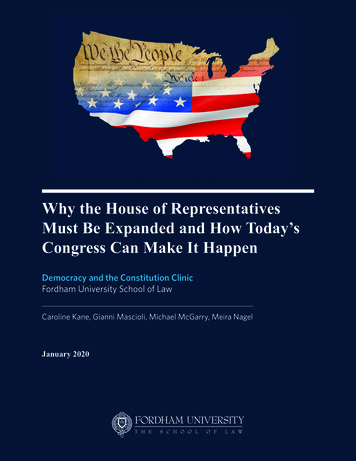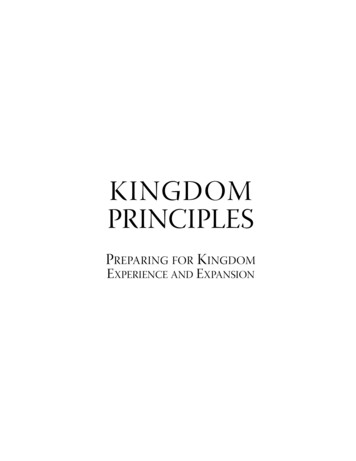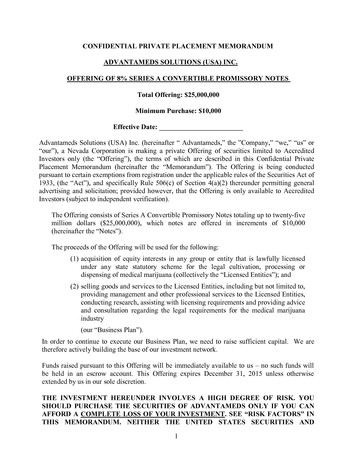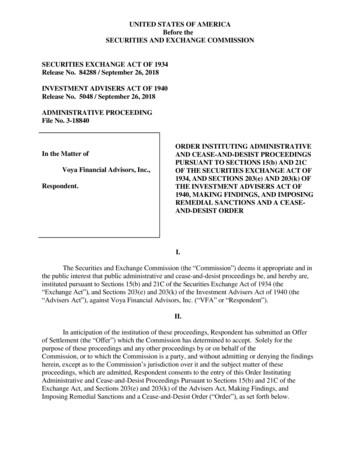
Transcription
Why the House of RepresentativesMust Be Expanded and How Today’sCongress Can Make It HappenDemocracy and the Constitution ClinicFordham University School of LawCaroline Kane, Gianni Mascioli, Michael McGarry, Meira NagelJanuary 2020Democracy Clinici
Why the House of RepresentativesMust Be Expanded and How Today’sCongress Can Make It HappenDemocracy and the Constitution ClinicFordham University School of LawCaroline Kane, Gianni Mascioli, Michael McGarry, Meira NagelJanuary 2020This report was researched and written during the 2018-2019 academic year by students in Fordham Law School’sDemocracy and the Constitution Clinic, which is focused on developing non-partisan recommendations to strengthenthe nation’s institutions and its democracy. The clinic is supervised by John D. Feerick and John Rogan.Acknowledgments:We would like to express our gratitude to the esteemed experts who generously took time to sharetheir knowledge and views with us: Kevin Baas, John O. Brennan, Jerry H. Goldfeder, Derek Hackett,Representative Jerrold Nadler, Dr. Norman Ornstein, Representative Jamie Raskin, Representative ThomasSuozzi, and Jesse Wegman.This report greatly benefited from Gail McDonald’s research guidance and Erandi Trevino’s editingassistance. Judith Rew and Robert Yasharian designed the report.
Table of ContentsExecutive Summary. . 3Introduction.4I.A History of Representation.5A.The People’s House.5B.Growth of the House and the Permanent Apportionment Act.6C.The House Today.7II. Why The House Must Be Expanded. .8A.Local Responsiveness and Equal Representation.8B.Mitigating Partisan Gerrymandering. 8C.Electoral College Parity.8D.Preventing Corruption and Capture by Special Interests.9E.Third Party Representation.9F.Diversity.9G.Party Conformance and Control.9H.Scope of Work.9J.Responding to Critics.10III. Expanding the House. 11A.Four Methods of Expansion. 11B.Recommendation. 17IV. Drawing Districts for an Expanded House. 19A.Background. 19B.The Need to End Gerrymandering. 19C. Recent Proposed Gerrymandering Solutions.20D.Primary Allocation Proposal. 21E.A Legislative Answer to a Persistent Problem. 24Conclusion.252Why the House of Representatives Must Be Expanded
Executive SummaryThe House of Representatives is not functioning how theConstitution’s framers intended. To ensure that the bodyprovides fair and democratic representation, the size of theHouse must expand and a new approach should be used fordrawing congressional districts.Other than setting a minimum of at least 65 representativesand requiring that each state have at least one, the Constitutiondoes not specify a size for the House. But the framers intendedfor the size to increase alongside the country’s population,which essentially happened until 1910.In 1910, Congress approved a reapportionment of Houseseats and an increase in the size of the House to 433.The membership was further increased to 435 in 1912 toaccommodate the entry of Arizona and New Mexico asstates. However, Congress was unable to pass legislationreapportioning the House in 1920. Congress finally passed newlegislation in 1929, but it froze the size of the House at 435.That number, however, was an arbitrary cap. In the interest ofpolitical expediency, those members who voted for the limitforced their successors to represent two to three times as manyconstituents as they themselves represented. The cap of 435members still exists today, and it creates a host of problems forour representative democracy.An expansion of the House is important for several reasons.First, each member of the House represents—on average—about 750,000 constituents. In 2050, it is projected that eachmember of Congress will represent a million or more people.Everything a congressperson does will become even morechallenging. Some responsibilities might be entirely neglected.Americans who depend on their representatives for help willbe one of a million. Second, the 435-member cap createsunequal representation among districts. That district sizesvary so greatly throughout the country is problematic—thequality of representation Americans receive in the Houseshould not depend on the district in which they reside. Thisdisparity extends to presidential elections because the numberof electors that each state receives in the Electoral College isthe total of its representation in the House and Senate. Third,increasing the size of the House may, in fact, help to fix theissue of partisan gerrymandering. The more districts there are,the harder it becomes to gerrymander effectively. Increasingthe size of the House means more accountability, betterrepresentation, and increased diversity in Congress.How many seats should be added to the House? We proposeusing the Cube Root Rule to determine the number. Under theCube Root Rule, the size of a country’s legislature is the cubedroot of the country’s population. This means the number ofHouse seats would be the cubed root of the U.S. population,minus 100 (to account for the 100 Senators). Based on the2010 census, this approach would add 141 seats to the House(and decrease the average constituency size to around540,000 people). Adhering to the Cube Root Rule would putthe U.S. in good company with many other democratic nations.Importantly, the Cube Root Rule should be implemented asa permanent formula to determine House seats so Congresswould not need to pass a new law every time the populationsignificantly changes. The Cube Root Rule simply respondsto population changes—as the U.S. population increases ordecreases, so can the size of Congress.To draw districts following the House expansion, werecommend a novel plan: the Primary Allocation Model. Thissystem would practically eliminate partisan gerrymanderingand it would increase voter turnout in congressional elections.Under the Primary Allocation approach, there would be two“election rounds.” The first round would take place four to sixmonths before the second round. All voters would registerwith a political party (or remain independent) before the firstround. The first round would be open to the entire state. Voterswould cast votes for their preferred political party, not for aspecific candidate. Districts would then be allocated to politicalparties based on results of the first round. Each political partywith multiple districts would draw a district map across theentire state. A political party with one district would have an“at large” district covering the entire state. The second round ofthe elections would have the declared candidates campaigningagainst members of their own party in their districts. Voters inthe second round would be eligible to vote only for candidatesof the party they supported in the first-round election.Allowing political parties to create their own districts would endthe incentive for partisan gerrymandering. Elections would alsobe far more competitive, which would inspire more voters tocome to the polls.Democracy Clinic3
Introduction“The truth is, that in all cases, a certain number at least seemsto be necessary to secure the benefits of free consultation anddiscussion, and to guard against too easy a combination forimproper purposes; as on the other hand, the number oughtat most to be kept within a certain limit, in order to avoid theconfusion and intemperance of a multitude.”1—James Madison, Federalist No. 55In 1929, there were 435 members of the House ofRepresentatives. If that number seems familiar, it may bebecause in 2020 there are still 435 members of the House.14The Federalist No. 55 (James Madison).Why the House of Representatives Must Be ExpandedThis is by design—a 1929 law capped the number of Housemembers at 435. Today, this law causes many problems forour representative democracy, primarily because dramaticgrowth in the U.S. population has created exceedingly largecongressional districts. This report addresses how to fix theproblems inherent with large districts. Part I looks at the historyof the House, with an emphasis on size and seat allocation.Part II discusses the reasons the House should be expanded.Part III analyzes methods for expanding the House, ultimatelyrecommending a population-based mathematical rule. Finally,Part IV discusses a serious problem created by large districts—partisan gerrymandering—and offers a solution.
I. A History of RepresentationA. The People’s HouseThe concept of fair representation has been a crucial elementof American government since the nation’s founding. TheRevolution was, in part, a contest about the very definitionof representation. In England, the House of Commonsrepresented every British subject regardless of whether all ofthe subjects could actually vote for the Commons’ membership.In this sense, most people living in areas under British rule—including North America—were only “virtually represented”in Parliament.22 American colonists, who were accustomedto controlling their local affairs in the directly-elected coloniallegislatures, lacked a voice in Parliament and resented theBritish policies imposed on them. They rallied behind the nowfamiliar motto: “No taxation without representation!”3 After thewar, the founders struggled to design a system of governmentto better represent the inhabitants of the new country. TheArticles of Confederation created the first national congressto represent the interests of the states; under the Articles,each state appointed between two and seven delegates to thecongress, and each state delegation had one vote.4This system proved unworkable. The Articles did not vestenough power in congress to effectively govern national affairsand prevent interstate conflict.5 The founders had largelyavoided complicated questions of how to balance the interestsof different states and their citizens in national policymakingby leaving most fundamental governing issues to statelegislatures.6 The failure of this model led the delegates to theConstitutional Convention of 1787 to design a system with astronger national government. A key question was how sucha government would best represent and empower individuals,communities, and states across the nation.One of the main concerns that overtook the Convention was thesize of the House of Representatives.7 It was part of the strugglebetween large and small states that colored most of theConvention. Pennsylvania Delegate Benjamin Franklin summedup the disagreement, observing,If a proportional representation takes place, the smallStates contend that their liberties will be in danger. If anequality of votes is to be put in its place, the large Statessay their money will be in danger. When a broad table is tobe made, and the edges of planks do not fit, the artist takesa little from both and makes a good joint.8The “good joint” that emerged from weeks of gridlock wascalled the “Great Compromise.” It created a bicamerallegislature with a House, where state population determinedmembership, and a Senate, where each state had two seatsregardless of population.9The House of Representatives was intended to be the branchof government most intimately tied to popular will. FederalistNo. 52, which either James Madison or Alexander Hamiltonauthored, argued the House should have “an immediatedependence on, and intimate sympathy with, the people.”10Members of the House have been directly elected by Americanvoters since the chamber’s formation.11 Unlike the Senate, theHouse is not a continuing body. Its members must stand forelection every two years, after which it convenes for a newsession and essentially reconstitutes itself—electing a Speaker,swearing-in the members, and approving a slate of officersto administer the institution. Direct, biennial elections andits relatively large size have made the House receptive to acontinual influx of new ideas and priorities that contribute to itslongstanding reputation as the “People’s House.”The framers intended for the House to continuously grow.12Most agreed that the strength of the lower house would bederived from the continued ability of the representatives toaccurately reflect the “interests and circumstances” of theirconstituents.13 Only through gradual expansion would theHouse remain a democratic and truly representative institution.81 Records of the Federal Convention of 1787, at 488 (Max Farrand ed., 1911).9See id. at 524.10 The Federalist No. 52.11U.S. Const. art. I, § 2.2See Edmund S. Morgan, Colonial Ideas of Parliamentary Power 1764-1766, 5Wm. & Mary Q. 311, 331-34 (1948).3Id.4See Articles of Confederation of 1781, art. V.5John Ferling, A Leap in the Dark: The Struggle to Create the American 291(2003).12 See Christopher St. John Yates, A House of Our Own or A House We’veOutgrown? An Argument for Increasing the Size of the House of Representatives,25 Colum. J.L. & Soc. Probs. 157, 175-79 (1992); see also The Federalist No.58 (James Madison) (explaining that one of the purposes of the DecennialCensus was “to augment the number of representatives under the solelimitation that the whole number shall not exceed one for every thirtythousand inhabitants”).6Id.13 Yates, supra note 12, 178-79.7See Akhil Reed Amar, America’s Constitution: A Biography 78 (2005); see alsoFerling, supra note 5, at 292.Democracy Clinic5
B. Growth of the House and the PermanentApportionment ActAs the U.S. population grew in the nation’s early history,so too did the size of the People’s House. The Constitutionimposed only one limit on the House’s size: that the “Numberof Representatives shall not exceed one for every thirtyThousand.”14 Though an amendment was attempted after theConvention to tie the House’s size to the nationwide population,it fell short of ratification by one state.15The Constitution requires reapportionment of House seatsevery ten years following the census.16 Congress has usedseveral methods to determine the size of the House and theallocation of its seats.17Congress initially used what has been called the Jeffersonmethod.18 This approach involved setting a desired populationto-representative ratio, such as 30,000 to 1, and then dividingeach state’s population by the population figure in the ratioto determine the size of each state’s respective Housedelegation.19 Under this approach, decimals are rounded to thelowest whole number.20 If a state’s population was 920,000and the ratio chosen was 30,000 to 1, the formula would givethe state 30 representatives after rounding down from 30.66.Congress used the Jefferson method through the expansionbased on the 1830 census.21 For the rest of the 19th century,Congress used either the Webster or Hamilton method, whichinstead asked Congress to choose a number of representativesand used people-to-representative ratios and rounding toensure appropriate allocation of those seats.22 In any case, thesize of the House steadily increased during this period—thoughthe ratio of people to representatives had increased to roughly70,000 by 1830. Following the 1830 census, the House hadgrown to 240 members from 105 after the first apportionmentin 1792.23By the mid-1800s, some legislators were beginning toquestion whether the House should continue to expandand whether Congress should engage in a debate over theissue every decade. A permanent apportionment bill settingthe size of the House at 233 was enacted by Congress in1850,24 though Congress effectively ignored that cap andcontinued expanding in successive decades.25 Followingthe Civil War, the population expanded dramatically dueto heavy immigration from Southern Europe to Americancities.26 By 1900, the House had reached 386 membersand was expanded to 433 following the 1910 census.27 Twomore states, Arizona and New Mexico, entered the Union inthe following decade, bringing the total membership to themodern cap of 435.28 In 1920, it was anticipated that to avoidany single state losing a representative, the membershipwould need to be expanded by another 60 seats.29Members of Congress began to believe that the size of theHouse needed to be capped. While some argued for continuedexpansion to allow the House to better represent constituents,others asserted that a larger size would prevent the Housefrom functioning efficiently.30 Immigration also impactedthis debate—rural representatives were fearful that the 1920apportionment would result in urban areas receiving severalnew seats, which would give those communities much greaterrelative power in the legislature.31 Division over the issueprevented the House from being expanded following the 1920census.32Debate on the apportionment issue in Congress lingeredthrough the 1920s without a resolution.33 With the 1930 censusapproaching, public pressure was coming to bear on the issue,as the population of several states had grown significantly,and the allocation of representatives had remained entirelyunchanged. In 1928, the House took up a bill that would capits membership at 435 representatives and establish anautomatic allocation procedure following the upcoming census.14 U.S. Const. art. I, § 2, cl. 3.15 See Richard Edward McLawhorn Jr., Apportionment or Size? Why the U.S.House of Representatives Should Be Expanded, 62 Ala. L. Rev. 1069, 1072(2011).16 U.S. Const. art. I, § 2.17 See McLawhorn, supra note 15, at 1070-76; Methods of Apportionment,U.S. Census Bureau, tionment/methods of apportionment.html.18 Michel L. Balinski & H. Payton Young, Fair Representation: Meeting the Ideal ofOne Man, One Vote 23 (2001).19 Id. at 10-11.20 Id. at 11.21 McLawhorn, supra note 15, at 1074.22 Id. at 1074-75.23 Id. at 1074.6Why the House of Representatives Must Be Expanded24 Balinski & Young, supra note 18, at 37.25 McLawhorn, supra note 15, at 1075.26 Byron J. Harden, House of the Rising Population: The Case for Eliminating the435-Member Limit on the U.S. House of Representatives, 51 Washburn L.J. 73,79 (2011-2012).27 McLawhorn, supra note 15, at 1075.28 Charles A. Kromkowski & John A. Kromkowski, Why 435? A Question ofPolitical Arithmetic, 24 Polity 129, 133 (1991).29 McLawhorn, supra note 15, at 1076.30 Id.31 Harden, supra note 25, at 79.32 Kromkowski & Kromkowski, supra note 28, at 134.33 McLawhorn, supra note 15, at 1077.
Ultimately, the legislation gave Congress approval power overthe method used in any given reapportionment, with a defaultto the method used in the prior reapportionment if no approvalwas given.34 The Permanent Apportionment Act became law in1929.35C. The House TodayThe Permanent Apportionment Act continues to dictate thesize of the House and the allocation of seats among the states.The issue has not been substantively revisited by Congresssince the Act’s passage nearly a century ago, and it has receivedlimited scholarly attention in recent decades. As a result,congressional districts have more than tripled in size over the34 See Yates, supra note 12, at 180.35 The Permanent Apportionment Act of 1929, U.S. House of -Act-of-1929/.last century—from an average of roughly 212,000 inhabitantsafter the 1910 Census to about 710,000 inhabitants followingthe 2010 Census.36 It is projected that each member ofCongress will represent a million or more people by 2050.37At a minimum, the ballooning size of districts suggests theHouse is functioning in a way that provides lower qualityrepresentation to constituents than when Congress’smembership froze in 1911.38 In recent years, a small number ofscholars and journalists have begun arguing that apportionmentshould be revisited as a matter of democratic prerogative.39 Thisis where our analysis begins.36 United States Population Projections: 2000-2050, U.S. Census Bureau, lytical-document09.pdf.37 Id.38 See Richard J. Pierce, Jr., The Role of the Judiciary in Implementing anAgency Theory of Government, 64 N.Y.U. L. Rev. 1239, 1248 (1989) (“TheFramers believed that the potential danger of factionalism in the Houseof Representatives would be counteracted by its close dependence onthe people and its impermanence relative to the other institutions ofgovernment.”).39 See, e.g., Editorial Board, America Needs a Bigger House, N.Y. Times (Nov.9, 2018), nion/expanded-house-representatives-size.html; Dylan Matthews, The Casefor Massively Expanding the U.S. House of Representatives, in One Chart, Vox(June 4, 2018), esentation-ratio-district-size-chart-graph; Chris Wilson, How to Fixthe House of Representatives in One Easy, Radical Step, Time (Oct. 15, s-number-seats/.Democracy Clinic7
II. Why The House Must Be ExpandedExpanding the House would allow the chamber to conform tothe framers’ vision for it and to modern political and popularnotions of what representative democracy should be. Weidentify eight discrete and distinct reasons for this change. Wealso respond to the primary arguments made by opponents of aHouse expansion.A. Local Responsiveness and EqualRepresentationAs districts grow in size,40 more constituents are deprived ofadequate representation. To win re-election, candidates arepractically required to bargain with some interest groups overothers within their districts. The interest groups and politicalminorities that candidates eschew are ultimately losers inthe electoral process, both deprived of a functional vote andrepresentation of their interests in the House. A larger Housecorrects for this issue by granting more representatives toeach state and allowing those new districts to capture thepreferences of a greater number of political communities.Large districts may make it harder for constituents to receivehelp navigating the federal bureaucracy. Many Americans relyon their members of Congress to obtain essential informationabout government programs and benefits. By 2050, Americanswho depend on their representatives for help will be one of amillion; members and their staffs will necessarily have to triageconstituent concerns to an even greater degree than they donow. Expanding the House would allow representatives toprovide more hands-on help to constituents and relieve theburden on each member’s staff.The cap on House members creates unequal representationamong districts.41 Each state’s congressional delegationchanges as a result of population shifts, with many states eithergaining or losing seats after each census. But this process isimperfect. Given the increasingly wide population disparitybetween small and large states, it is mathematically impossibleto ensure that each member represents the same numberof constituents, or even roughly the same number in manycases. Currently, Montana’s population of 1,050,493 peoplegrants it just one House member.42 Rhode Island, has only aslightly larger population, with 1,059,639 residents, but that’senough to give it two representatives, which grants Rhode40 Drew Desilver, U.S. Population Keeps Growing, but House of Representativesis Same Size as in Taft Era, Pew Research Ctr. (May 31, 2018), tives-is-same-size-as-in-taft-era/.41 Id.B. Mitigating Partisan GerrymanderingIncreasing the size of the House may limit partisangerrymandering.45 After seats are apportioned every tenyears, each state is responsible for drawing districts. Partisangerrymandering of these districts has been a feature ofAmerican democracy for centuries, but recent decades haveseen particularly extreme cases of statehouse majorities usingtheir districting power to greatly diminish the representation ofthe opposing political party.46 Larger legislatures make it moredifficult to gerrymander effectively.47 If there was a state with100 residents and 100 congressional districts, gerrymanderingwould be impossible; if there are 50 congressional districts, itwould not be impossible, but very difficult. The House wouldnever be expanded to such a point that gerrymandering couldbe wholly eliminated, but a larger House would make it harderto entirely lock out a political minority of representation andcement the majority’s hold on power.C. Electoral College ParityEach state’s vote total in the Electoral College is derivedfrom its total congressional representation—the sum of itstwo senators and its total House delegation.48 This meanslegislative apportionment and representation are inherentlytied to presidential selection. The lack of parity in Houseapportionment among states impacts states’ influence inthe Electoral College. Large states would be the primary43 Id.44 See Reynolds v. Sims, 377 U.S. 533, 558 (1964).45 Harden, supra note 26, 98-99.46 See, e.g., Shelby County v. Holder, 570 U.S. 529 (2013); Alabama LegislativeBlack Caucus v. Alabama, 135 S. Ct. 1257 (2015); Cooper v. Harris, 137 S. Ct.1455 (2017). See also Gerrymandering at the Supreme Court, Brennan Ctr. forJust., s (last visitedAug. 9, 2019).47 Id.48 See U.S. Const. art. II, § 1, cl. 2.42 Id.8Islanders one representative for every 529,820 residents.43Courts have not applied the “one person, one vote” doctrineto congressional districts across state lines; it is only arestriction on the drawing of legislative districts within states.44However, constitutional doctrine notwithstanding, the qualityof Americans’ representation should not depend on the statethey happen to live in. Increasing the number of representativeswho can be allocated among the states makes the task ofequal apportionment easier by increasing the pool of seatsto be equally divided and produces more parity in interstaterepresentation ratios.Why the House of Representatives Must Be Expanded
beneficiaries of a House expansion because they typically havehigher than average population-to-representative ratios due tothe limited number of seats and the requirement that each statereceive at least one. But some small states, such as Montana,that have high ratios would also benefit. Expanding the Housemitigates these parity disadvantages and cabins the small-stateadvantage in the Electoral College to the two-vote baseline,which is the advantage the system was originally intended toconfer.D. Preventing Corruption and Capture bySpecial InterestsA stagnant political body is vulnerable to capture by powerfulinterests. The House is no exception. This concern wasparamount among supporters of the proposed constitutionalamendment in the Framing Era to
Congress Can Make It Happen Democracy and the Constitution Clinic Fordham University School of Law Caroline Kane, Gianni Mascioli, Michael McGarry, Meira Nagel January 2020. Why the House of Representatives Must Be Expande

![[Page 1 – front cover] [Show cover CLEAN GET- AWAY 978-1 .](/img/13/9781984892973-6648.jpg)








